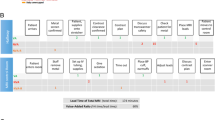Abstract
The Skaraborg Hospital Group (SkaS) has implemented a variety of quality management initiatives in the last 20 years in accordance with its strategy of excelling at quality development to fulfill the needs and expectations of its patients. One such initiative is Six Sigma, which has contributed to more than 40 completed improvement projects. Using an action research approach, this article describes the lessons that were learned from the first 22 Six Sigma projects, completed between 2006 and 2008 and having a success rate of 75%. We further describe how these insights have contributed to other ongoing quality improvement activities at SkaS. In particular, the paper presents some key points not earlier described in other Six Sigma healthcare applications.
Similar content being viewed by others
References
Aagaard Nielsen K, Svensson L (eds) (2006) Action research and interactive research. Shaker Publishing, Maastricht
Adams R, Warner P, Hubbard B, Goulding T (2004) Decreasing turnaround time between general surgery cases. J Nurs Adm 3:140–148
Antony J, Downey-Ennis K, Antony F, Seow C (2007) Can six sigma be the “cure” for our “ailing” NHS? Leadersh Health Serv 4:242–253
Arndt M, Biegelow B (1995) The implementation of total quality management in hospitals: How good is the fit? Healthc Manag Rev 20:7–14
Bahensky JA, Roe J, Bolton R (2005) Lean sigma—will it work for healthcare? J Healthc Inf Manag 1:39–44
Bergman B, Klefsjö B (2003) Quality – from customer needs to customer satisfaction. Studentlitteratur, Lund
Berwick D, Nolan T (2003) The Breakthrough series—IHI’s collaborative model for achieving breakthrough improvement. IHI, Cambridge, MA
Boaden R, Harvey G, Moxham C, Proudlove N (2008) Quality improvement: theory and practice in healthcare. NHS Institute for Innovation and Improvement, Coventry
Bradbury H, Reason P (eds) (2008) The Sage handbook of action research. Sage Publications, London
Chakravorty SS (2009) Six sigma failures: An escalation model, Oper Manag Res. In press. doi:10.1007/s12063-009-0020-8
Cherry J, Seshadri S (2000) Six sigma: Using statistics to reduce process variability and costs in radiology. Radiol Manag nov/dec:42–45
Clifford L (2001) Why you can safely ignore six sigma. Fortune 143:140
Cronemyr P (2007) Six sigma management. Dissertation, Chalmers University of Technology
Dahlgaard JJ, Dahlgaard-Park SM (2006) Lean production, six sigma quality, TQM and company culture. TQM Mag 18:263–281
Dean JW Jr, Bowen DE (1994) Management theory and total quality. Improving research and practice through theory development. Acad Manag Rev 19:392–418
Deming WE (1986) Out of the crisis. MIT Press, Cambridge
Eriksson N (2005) Friska vindar i sjukvården (’Fresh breezes in healthcare’). Dissertation, Förvaltningshögskolan
Fillingham D (2007) Can lean save lives? Leadersh Health Serv 20:231–241
Fraser S (2002) Accelerating the spread of good practice: a workbook for health care. Kingsham Press, Chichester
Frings GW, Grant L (2005) Who moved my sigma? Effective implementation of the six sigma methodology to hospitals. Qual Reliab Eng Int 21:311–328
Goh TN (2002) A strategic assessment of six sigma. Qual Reliab Eng Int 18:403–410
Harry M, Schroeder R (2000) Six sigma—the breakthrough management strategy. Doubleday, New York
Hasselbladh H, Bejerot E, Gustafsson RÅ (2008) Bortom new public management—institutionell transformation i svensk sjukvård (’Beyond new public management—institutional transformation in Swedish healthcare’). Acadameia Adacta, Lund
Hellström A, Eriksson H (2007) Among fumblers, talkers, mappers and organizers—four applications of process orientation. Appended paper in Hellstrom A (2007) On the diffusion and adoption of management ideas. Dissertation. Chalmers University of Technology
Hellström A, Lifvergren S, Quist J (2010) Process management in healthcare—investigating why it’s easier said than done. J Manuf Technol 21:499–511
Hood C (1991) A public management for all seasons? Public Adm 69:3–19
Hyer NL, Wemmerlöv U, Morris J, Shtub A (2003) Cellular manufacturing in health care: the case of a trauma unit. In: Spina, J et al. (eds) One world? One view of OM? The Challenges of integrating research & practice. EurOMA–POMS Conference, Como, Italy, 16–18 June, Vol I:913–917
Institute of Medicine (2001) Crossing the quality chasm. National Academy Press, Washington
Ishikawa K (1982) Guide to quality control. Asian Productivity Press, Tokyo
Kammerlind P, Kollberg B (2007) Kvalitetsmetoder inom svensk hälso- och sjukvård (’Quality methods in Swedish healthcare’). In: Elg M, Gauthtereau Witell L (eds) Att lyckas med förbättringsarbete (’To succeed with improvements’). Studentlitteratur, Lund
Kaplan RS, Norton DP (1992) The balanced scorecard—measures that drive performance. Harv Bus Rev 10:1–31
Kaplan RS, Norton DP (2001) The strategy-focused organization. Harvard Business School Press, Boston
Kollberg B, Elg M (2006) Exploring the use of balanced scorecards in Swedish health care organizations. The Asian J Qual 2:1–18
Langley GJ, Nolan KM, Nolan TW (1992) The foundation of improvement. Silver Spring, MD
Lifvergren S, Chakhunashvili A, Bergman B. Docherty P (2008a). Online statistical monitoring of critical patient data increases patient safety. PICMET-conference, Proceedings, Capetown
Lifvergren S, Edin M, Rentzhog O, Tullberg S (2008b) Six Sigma i hälso- och sjukvården (‘Six Sigma in healthcare’). Sveriges Kommuner och Landsting (SALAR), Stockholm
Lifvergren S, Chakunashvili A, Bergman B (2009a) Using scientific problem solving methods to improve healthcare processes and increase patient safety. EurOMA-Conference, Proceedings, Gothenburg
Lifvergren S, Huzzard T, Docherty P (2009b) A development coalition for sustainability in healthcare. In: Docherty P, Kira M, Shani AB (eds) Creating sustainable work systems: developing social sustainability. Routledge, London
Lindgaard Laursen M, Gertsen F, Johansen J (2003) Applying lean thinking in hospitals exploring implementation difficulties. Center for industrial production, Aalborg University
McNulty T, Ferlie E (2002) Reengineering health care: The complexities of organizational transformation. Oxford University Press, Oxford
Nembhard IM, Alexander JA, Hoff TJ, Ramanujam R (2009) Why does the quality of health care continue to lag? Insights from management research. Acad Manag Perspect 23:24–42
OECD (2007) OECD Health Data: Statistics and indicators for 30 countries. OECD, Paris
Olsson J, Kammerlind P, Thor J, Elgh M (2003) Surveying improvement activities in health care on a national level—the Swedish internal collaborative strategy and its challenges. Qual Manag in Healthc 12:202–216
Øvretveit J (1997) A comparison of hospital quality programmes: lessons for other services. Int J Service Ind Manag 3:220–235
Øvretveit J, Gustafson D (2002) Quality improvement research—evaluation of quality improvement programmes. Qual and Saf in Healthc 11:270–275. doi:10.1136/qhc.11.3.270
Øvretveit J (2009) Does improving quality save money? A review of evidence of which improvements to quality reduce costs to health service providers. The Health Foundation, London
Plsek P (1998) Worldwide complexity: Strategic planning for a non-profit healthcare organization—“non-business" plan approach to pursuing an international opportunity. IHI, Boston
Prabhushankar GV, Devadasan SR (2008) The origin, history and definition of six sigma: a literature review. Int J Six Sigma Compet Advant 4:133–150
Radnor Z, Walley P (2008) Learning to walk before we try to run: Adapting lean for the public sector. Public Money and Manag 28:13–20
Revere L, Black K (2003) Integrating six sigma with total quality management: A case example for measuring medication errors. J Healthc Manag 48:377–391
Schroeder RG, Linderman K, Liedtke C, Choo AS (2008) Six sigma: Definition and underlying theory. J Oper Manag 26:536–554
Shani AB, Docherty P (2003) Learning by design: Building sustainable organizations. Blackwell, London
Shani AB, Docherty P (2008) Learning by design. Key mechanisms in organization development. In: Cummings TG (ed) Handbook of organization development. Sage Publications, California
Shortell SM, O’Brien JL, Carman JM, Foster RW, Hughes EF, Boerstler H, O’Connor EJ (1995) Assessing the impact of continuous quality improvement/total quality management: Concept versus implementation. Health Serv Res 30:377–401
Simmons D, Cenek P, Counterman J, Hockenhury D, Litwiller L (2004) Reducing VAP with six sigma—use quality improvement methodologies to enhance core patient care process. Nursing Manag 35:41–45
Smith B (1990) The Motorola story. Lecture by Bill Smith, Senior Quality Manager at Motorola at World Class Quality Event, March 1990, Västerås, Sweden
Spear S (2005) Fixing healthcare from the inside, today. Harvard Bus Rev Sept online version: 1–20
Stahl R, Schultz B, Pexton C (2003) From incremental improvement to designing the future. Six Sigma Forum Mag 2:17–26
Swedish Department of Treasury (2005) Iaktagelser om landsting (‘Observations on counties’) DS 2005:7 (online http://www.sweden.gov.se/sb/d/108/a/41627)
Thor J, Herrlin B, Wittlöv K, Øvretveit J, Brommels M (2007) Evolution and outcomes of a quality improvement program. Appended paper in Thor J (2007) Getting going on getting better. Dissertation. Department of Learning, Informatics, Management and Ethics, Karolinska Intitutet
Tucker AL, Edmondson AC (2003) Why hospitals don't learn from failures: organizational and psychological dynamics that inhibit system change. Calif Manag Rev 45, no 2 (winter)
Tucker AL, Nembhard IM, Edmondson AC (2007) Implementing new practices; an empirical study of organizational learning in hospital intensive care units. Manag Sci 6:894–907
van Heuvel J, Does R, Vermaat MB (2004) Six sigma in a Dutch hospital: does it work in a nursing department? Qual Rel Eng Int 20:419–426
Westphal JD, Gulati R, Shortell SM (1997) Customization or conformity? An institutional and network perspective on the content and consequences of TQM adoption. Adm Sci Q 42:366–394
WHO (2000) World Health Report 2000. WHO Library Cataloguing in Publication Data, Geneva
Woodard TD (2005) Addressing variation in hospital quality: is six sigma the answer? J Healthc Manag 50:226–236
Yasin MM, Zimmerer LW, Miller P, Zimmerer TW (2002) An empirical investigation of the effectiveness of contemporary managerial philosophies in a hospital operational setting. Int J Healthc Qual Assur 15:268–276
Young GJ, Charns MP, Shortell SM (2001) Top manager and network effects on the adoption of innovative management practices: a study of TQM in a public hospital system. Strateg Manag J 22:935–951
Zu X, Fredendall LD, Douglas TJ (2008) The evolving theory of quality management: the role of six sigma. J Oper Manag 26:630–650
Author information
Authors and Affiliations
Corresponding author
Rights and permissions
About this article
Cite this article
Lifvergren, S., Gremyr, I., Hellström, A. et al. Lessons from Sweden’s first large-scale implementation of Six Sigma in healthcare. Oper Manag Res 3, 117–128 (2010). https://doi.org/10.1007/s12063-010-0038-y
Received:
Revised:
Accepted:
Published:
Issue Date:
DOI: https://doi.org/10.1007/s12063-010-0038-y




